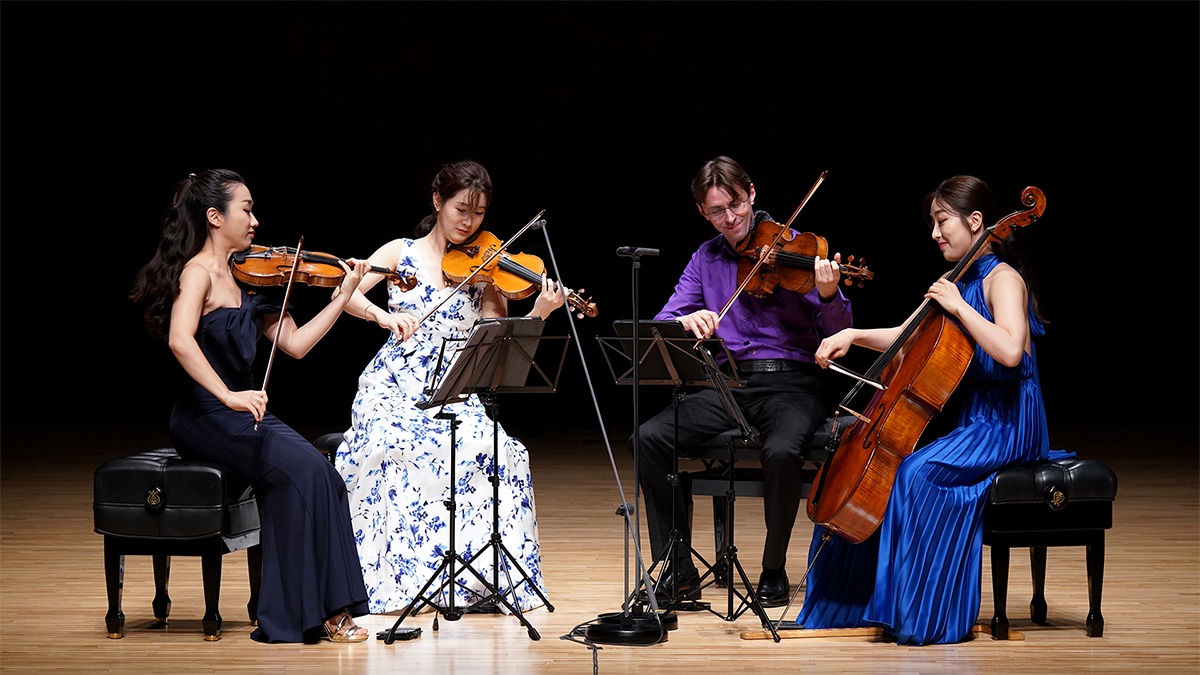In Australian composer Jack Frerer’s Spiral Sequences (2018), centripetal and centrifugal forces conspire to draw in and fling out musical patterns and sequences that serendipitously evoke the sparkling late classicism of a teenage Mendelssohn and rich romanticism of a young Webern.
Serendipitously, because in the context of this auspiciously brilliant first concert by the equally youthful Esmé Quartet’s first Australian tour for Musica Viva, Spiral Sequences neatly summarised (in reverse) Webern’s 1905 Langsamer Satz (Slow Movement) and Mendelssohn’s String Quartet No. 2 in A minor, Op. 13 (1827), both heard before the interval.
Not only that: it also pointed forward to the marvellous metamorphoses and arabesques of the final work in the program, Debussy’s String Quartet in G minor, Op. 10.

Esmé Quartet. Photo supplied
Thus, while the German-based Esmé Quartet’s newest member, violist Dimitri Murath admitted following the Webern that there was no particular theme for the program, there is nevertheless a satisfying affective balance among the four works which certainly on this occasion made for an intense, compact listening experience.
Especially given the quality of the performances. Despite having only formed in 2016, the Esmé Quartet (the other players, all Korean-born, are violinists Wonhee Bae and Yuna Ha and cellist Yeeun Heo) has already achieved an enviable international reputation for the elegance, precision and energy of its playing.
If romanticism carried the seeds of its own destruction in the accelerated use of, amongst other elements, chromaticism and dissonance, the Esmé Quartet crisply reminded us, in the Brahmsian Langsamer Satz and Beethovian String Quartet No. 2 in A minor that these works stand as mini-monuments to a youthful but affectionate bucking against tradition.
And if, in the Webern, the players’ exquisite balancing of the tension between the inner voices and the gossamer etching of yearning outer melodies was a sign of great things to come, the urbane ferocity exhibited in the despatching of the outer movements and the rhetorically-charged poise of the inner movements more than delivered on the promise.
But what a thrilling, committed account of US-based Frerer’s Spiral Squences, too! This is new music that stays news by unashamedly drinking from tradition’s wellsprings while, in Jack’s own words, evoking “the feeling of a big city … jarring juxtapositions, surprises around every corner.”
So, both urban and urbane. The playing reflecting this refracted rather than fractal quality with a clear, firm projection of structure leavened by sonic glazes pointing up the pullulating melodic undergrowth.
A farewell to (traditional) form, Debussy’s similarly Janus-like string quartet – his only foray into that genre – feels French perhaps only in hindsight, melding timeworn structures with novel ways of organising sound in time. As far as a ‘linear’ Debussy goes, it’s an astonishingly sensuous work.
Here, the Esmé Quartet was very much in its element, careful not to guild the motivic lily, patiently allowing the recurring material to do its work, often content merely to clarify modal tonalities and contrasting articulations – the vivid realisation of the pizzicato and bowed textures were a particularly strong feature – with fidelity and humility.
Music Viva presents Esmé Quartet: Adelaide Town Hall (1 May); Hobart Town Hall (3 May); City Recital Hall, Sydney (6 May); Newcastle City Hall (7 May); Llewellyn Hall, ANU, Canberra (10 May); QLD Conservatorium Theatre, Brisbane (13 May) and Melbourne Recital Centre, 14 May.











Comments
Log in to join the conversation.